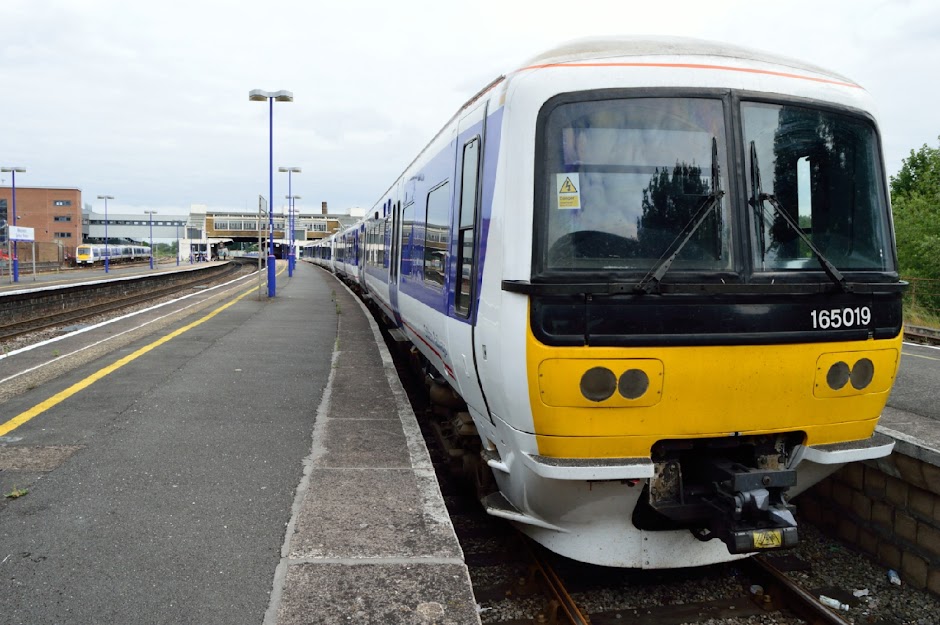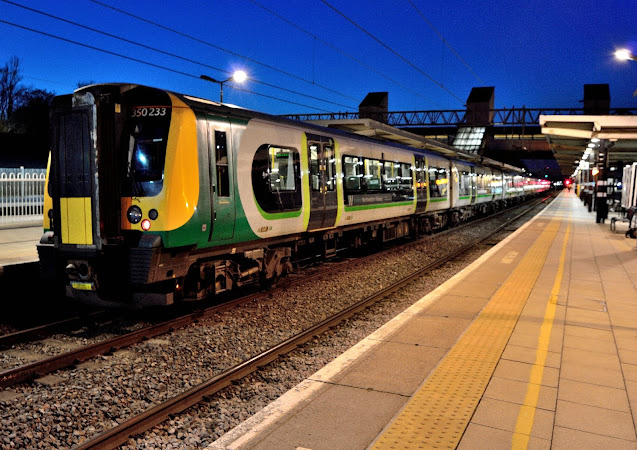Fifteen Historical UK Railway Facts
 |
| Southern Railway Steam Locomotive 4-4-0 Schools Class 30904 'Lancing' Basingstoke |
Recorded in 1952, Class 30904 carried a home loco shed code of 74E, the location of which was St. Leonards, Sussex.
 |
| St. Leonards Loco Shed |
Railway Facts & Trivia
Throughout
every walk of life, events happen which, when put together, create
history. And so it is with Britain's railway network.
Since
George Stephenson's locomotive 'Rocket'
rattled along the rails at
the Rainhill Trials in October 1829, many of the events occurring on
the railways have been recorded.
Here then
are fifteen interesting examples that created railway history to a greater or
lesser extent.
The
Duke of Wellington:
Although
the Duke of Wellington, 'Iron Duke' - hero of the Battle of Waterloo - officially opened
the Liverpool & Manchester Railway in 1830, the 'great man' had a
snobbish attitude towards anyone who was not of the British elite
and definitely against this new and radical form of travel.
He
stated publicly that because of the railways, sedition and revolution
would easily spread throughout the country by the 'lower
orders'.
Never
on a Sunday:
The
ultra-religious Victorians disagreed strongly with rail travel
happening on Sundays. On one particular Sunday in 1883 a group of
protesters tried to prevent fish being loaded onto a train. Ten
people were arrested during the ensuing skirmish who, when released,
were hailed as heroes by their fellow villagers.
By
1889, eight thousand members had joined the 'Anti-Sunday Travel
Union', who had nearly sixty branch offices up and down the country.
A
Day Out for Everyone:
With
the advent of the railways, Victorian working-class families were at
last able to take advantage of a cheap one-day holiday.
Such was the
popularity of these inexpensive excursions that, in 1849, around 100,000 thousand people travelled on special trains to Liverpool in order to
witness, at first-hand, the public execution outside Kirkdale Prison, Liverpool, on the 15th September 1849 of the infamous murderer, John Gleeson Wilson.
Letting
the Train Take the Strain:
With
the coming of the railways the number of people travelling on the
network increased to an extent that could never have been imagined.
In 1842, over 24 million passengers had used the railways. By 1850
numbers had risen to a staggering 73 million!
Queen
Victoria on the Rails:
Although
Queen Victoria travelled quite regularly on the railways, she was
never completely comfortable with the idea. She much preferred
taking a journey in a horse-drawn carriage.
However,
her first journey by train, from Windsor Castle to Buckingham Palace
on the 13th June 1842, was not taken through personal choice but as a
result of two assassination attempts two weeks earlier. Her advisors
believed she would be less vulnerable in a railway.
On
the footplate of the locomotive used for this trip was none other
than the famous engineer, Isambard Kingdom Brunel.
“Don't
encourage the working classes”:
In
the early days of rail travel three classes of accommodation
developed over time.
First class travellers enjoyed a good measure
of luxury; a glazed door to each compartment, armrests, padded
upholstery, oil-lamp lighting etc. Second class passengers were only
slightly worse off, but third class passengers were treated no better
than animals.
As
no railway company provided dedicated third-class carriages, the
unfortunate travellers rode in goods wagons completely open to the
elements. They sat on backless wooden benches with holes drilled in
the floor to allow the rainwater to escape.
If
any class of passenger unfortunately needed the toilet during a journey...well that
was a totally different matter completely.
Karl
Marx didn't get the job:
Described
as the father of modern communism, Karl Marx, who famously pronounced
that, "the workers have nothing to lose but their chains",
failed to get a job on the Great Western Railway - his handwriting
was simply not good enough!
The
Biggest of the 'Big Four':
In
1923 the London Midland & Scottish Railway was the largest of the
'Big Four' railway companies; the other three contenders to the title
being the Great Western, the Southern, and the London & North
Eastern.
The
'LMS' employed a quarter of a million people; operated across 7,000
miles of track, had 3,000 goods depots and 2,000 stations. Before
the nationalisation of the railways in 1948, it was the biggest
private transport company in the world moving 85 million tons of coal
a year.
"Good
Morning Campers":
Camping
railway coaches were a popular form of holiday accommodation in the
1930's, with the railway companies placing old vehicles on disused
sidings in attractive places and equipping them with kitchens,
toilets and washing facilities.
The
peak weekly rental charged by the London & North Eastern Railway
(L&NER) was around £2. Since its coaches could take up to six
holiday-makers, this was a bargain price when the cost was shared
between individuals.
On
one particular occasion the company was quick to make a profit.
During
'Coronation Week' in 1937 - when London was invaded by sightseers -
the LNER placed 52 camping coaches at various sites around London,
charging £10 per coach - five times the normal rent!
A
Grave Incident Indeed:
When
the plans for London's St. Pancras station were drawn up, it emerged
that the approach lines would pass right through an old cemetery. As
nothing could stop the rapid advance of the railways, it meant that
the area had to be completely cleared.
Reports
in newspapers soon reached the general public that gravestones were
being ripped up and placed in piles; the bones of the dead being
scattered on the ground. Perhaps the most deplorable act perpetrated
by the railways builders was that others were being sold to local
bone-mills to be ground up for fertilizer.
The
slum dwellings that were on the site - where the station now stands -
were demolished. The inhabitants were simply evicted - all 10,000 of
them!
One
Drink Coming Up Sir!:
When
the railway companies built their lines they invariably constructed a
large number of railway hotels near to their stations in the larger
towns and cities. The first, a very basic establishment known as the
'Victoria' close
to Euston station, opened in 1839.
One
of the most popular railway hotels was the 'Queen's' in Birmingham,
opened by the London & North Western Railway in 1854. Some of
the guests that came through its doors included Queen Victoria,
General de Gaulle and Roy Rogers accompanied by his horse 'Trigger'.
Many
people visited the hotel not only to spot the rich and famous, but to
witness the hotel's famous barman, 'Flash' Battersby, at work. It
was claimed that Battersby was able to slide a drink along 6 metres
(20ft) of bar top, bringing it to a stop directly in front of the
customer in question!
Railway
Station of the Stars:
Due
to its location at the London end of the railway line from
Southampton, Waterloo station was ideally situated to bask in the
publicity generated by the numerous celebrities visiting Britain from
America.
When
the famous piano-playing entertainer Liberace arrived at Waterloo in
1956, he was met by thousands of fans who had laid a carpet of pink
paper rose petals along the platform in his honour.
The
Railways Go To the Movies:
It
was inevitable that the railways would in time attract the attention
of movie-makers.
In
1895 the French Lumiere brothers made the first railway film; a
15-minute film of a bustling station and the arrival of a steam train
pulling four coaches. The film was screened in Paris on 28th
December 1895 as part of the world's first public cinema show. The
railway movie was born!
Britain's
First Railway Murder:
On
the 9th July 1864, elderly London bank clerk, Thomas Briggs, boarded
a train at Fenchurch Street station bound for Hackney.
Sadly he
never reached his destination. He was found at the side of the railway tracks between the two stations by the locomotive crew of a train
heading into London, and died the following day from the massive head
wounds he had received.
Following
information received, Inspector Tanner of Scotland Yard quickly
established robbery as the motive for the murder, and a likely
suspect was named - Franz Muller.
Before
the murderer could be apprehended he left England for America aboard
a sailing ship. However, his escape plan failed when he was arrested
in New York.
Returned
to England, Franz Muller stood trial at the Old Bailey on 27th
October 1864 for the murder of Thomas Briggs. Found guilty, Muller
was publicly hanged on 14th November 1864 outside the walls of
London's Newgate Prison, in front of an estimated crowd of 50,000
people.
Women
on the Railways:
Up
until 1914, fewer than 5,000 women worked within the British Railway
network. Those that did were employed in the more traditional female
roles of the time such as in refreshment rooms, railway company
laundries etc.
However,
with the outbreak of WW1, this situation changed drastically.
To
offset the shortage of men, women were employed to undertake jobs
previously denied to them.
They
loaded heavy mail bags onto trains, acted as porters, collected
tickets, served as dining-car attendants and undertook many dirty
jobs such as carriage and locomotive cleaning, while others laboured
in the coal yards.
The
role of women in the workplace had changed forever!
Don't forget to subscribe to 'Along These Tracks' to get all new posts and updates sent directly to you.
Blog update:
Previous posts are now easier to find.
All blog posts are now listed alphabetically on the right side of your screen; under the heading, 'Previous Photo Posts'.
"I hope this makes your search easier".













